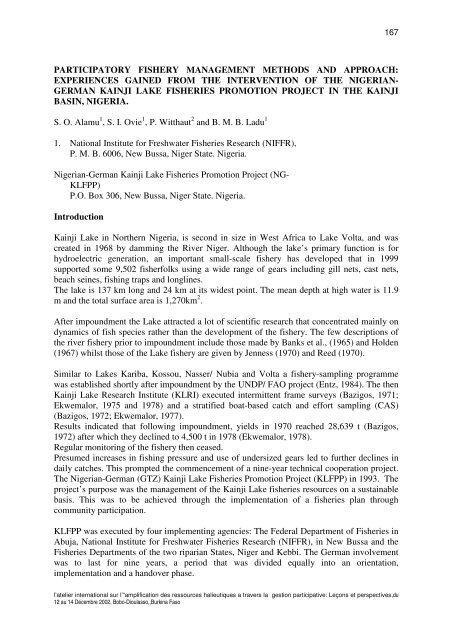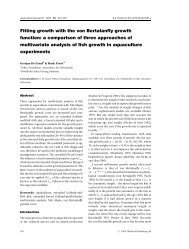RAPPORT GENERAL DE L'ATELIER ... - Nefisco.org
RAPPORT GENERAL DE L'ATELIER ... - Nefisco.org
RAPPORT GENERAL DE L'ATELIER ... - Nefisco.org
Create successful ePaper yourself
Turn your PDF publications into a flip-book with our unique Google optimized e-Paper software.
167<br />
PARTICIPATORY FISHERY MANAGEMENT METHODS AND APPROACH:<br />
EXPERIENCES GAINED FROM THE INTERVENTION OF THE NIGERIAN-<br />
GERMAN KAINJI LAKE FISHERIES PROMOTION PROJECT IN THE KAINJI<br />
BASIN, NIGERIA.<br />
S. O. Alamu 1 , S. I. Ovie 1 , P. Witthaut 2 and B. M. B. Ladu 1<br />
1. National Institute for Freshwater Fisheries Research (NIFFR),<br />
P. M. B. 6006, New Bussa, Niger State. Nigeria.<br />
Nigerian-German Kainji Lake Fisheries Promotion Project (NG-<br />
KLFPP)<br />
P.O. Box 306, New Bussa, Niger State. Nigeria.<br />
Introduction<br />
Kainji Lake in Northern Nigeria, is second in size in West Africa to Lake Volta, and was<br />
created in 1968 by damming the River Niger. Although the lake’s primary function is for<br />
hydroelectric generation, an important small-scale fishery has developed that in 1999<br />
supported some 9,502 fisherfolks using a wide range of gears including gill nets, cast nets,<br />
beach seines, fishing traps and longlines.<br />
The lake is 137 km long and 24 km at its widest point. The mean depth at high water is 11.9<br />
m and the total surface area is 1,270km 2 .<br />
After impoundment the Lake attracted a lot of scientific research that concentrated mainly on<br />
dynamics of fish species rather than the development of the fishery. The few descriptions of<br />
the river fishery prior to impoundment include those made by Banks et al., (1965) and Holden<br />
(1967) whilst those of the Lake fishery are given by Jenness (1970) and Reed (1970).<br />
Similar to Lakes Kariba, Kossou, Nasser/ Nubia and Volta a fishery-sampling programme<br />
was established shortly after impoundment by the UNDP/ FAO project (Entz, 1984). The then<br />
Kainji Lake Research Institute (KLRI) executed intermittent frame surveys (Bazigos, 1971;<br />
Ekwemalor, 1975 and 1978) and a stratified boat-based catch and effort sampling (CAS)<br />
(Bazigos, 1972; Ekwemalor, 1977).<br />
Results indicated that following impoundment, yields in 1970 reached 28,639 t (Bazigos,<br />
1972) after which they declined to 4,500 t in 1978 (Ekwemalor, 1978).<br />
Regular monitoring of the fishery then ceased.<br />
Presumed increases in fishing pressure and use of undersized gears led to further declines in<br />
daily catches. This prompted the commencement of a nine-year technical cooperation project.<br />
The Nigerian-German (GTZ) Kainji Lake Fisheries Promotion Project (KLFPP) in 1993. The<br />
project’s purpose was the management of the Kainji Lake fisheries resources on a sustainable<br />
basis. This was to be achieved through the implementation of a fisheries plan through<br />
community participation.<br />
KLFPP was executed by four implementing agencies: The Federal Department of Fisheries in<br />
Abuja, National Institute for Freshwater Fisheries Research (NIFFR), in New Bussa and the<br />
Fisheries Departments of the two riparian States, Niger and Kebbi. The German involvement<br />
was to last for nine years, a period that was divided equally into an orientation,<br />
implementation and a handover phase.<br />
l’atelier international sur l’“amplification des ressources halieutiques a travers la gestion participative: Leçons et perspectives,du<br />
12 au 14 Décembre 2002, Bobo-Dioulasso,,Burkina Faso



